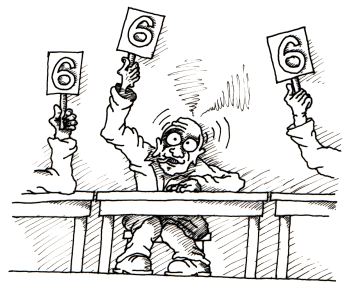 You are working with the text-only light edition of "H.Lohninger: Teach/Me Data Analysis, Springer-Verlag, Berlin-New York-Tokyo, 1999. ISBN 3-540-14743-8". Click here for further information.
You are working with the text-only light edition of "H.Lohninger: Teach/Me Data Analysis, Springer-Verlag, Berlin-New York-Tokyo, 1999. ISBN 3-540-14743-8". Click here for further information.
 You are working with the text-only light edition of "H.Lohninger: Teach/Me Data Analysis, Springer-Verlag, Berlin-New York-Tokyo, 1999. ISBN 3-540-14743-8". Click here for further information. You are working with the text-only light edition of "H.Lohninger: Teach/Me Data Analysis, Springer-Verlag, Berlin-New York-Tokyo, 1999. ISBN 3-540-14743-8". Click here for further information.
|
Table of Contents  Bivariate Data Bivariate Data  Correlation Correlation  Chance Correlation Chance Correlation |
|
| See also: variable selection, confounded variables, distribution of the correlation coefficient |   |
 Suppose
you have a data matrix of 6 variables and 13 observations filled with random
numbers. Now let us try a simple experiment: without loss of generality
we pick the first of the six variables, and try to model this variable
using the 5 remaining variables. Ideally, we should expect that it is impossible
to set up a regression model which creates a significant relationship between
any of the selected variables and the first variable. However, if we actually
perform the experiment, repeating it several times, we see that we obtain
considerable correlations between the predicted and the actual target values.
This effect is worsened, if more independent variables are used, and if
less observations are used. You may also use the following
Suppose
you have a data matrix of 6 variables and 13 observations filled with random
numbers. Now let us try a simple experiment: without loss of generality
we pick the first of the six variables, and try to model this variable
using the 5 remaining variables. Ideally, we should expect that it is impossible
to set up a regression model which creates a significant relationship between
any of the selected variables and the first variable. However, if we actually
perform the experiment, repeating it several times, we see that we obtain
considerable correlations between the predicted and the actual target values.
This effect is worsened, if more independent variables are used, and if
less observations are used. You may also use the following ![]() to gain some experience with this effect.
to gain some experience with this effect.
Go to the![]() to
carry out some trial calculations on your own. Use the mathematical formula
editor to fill a data matrix with random numbers and then try to establish
an MLR model between any number of independent variables and one selected
target variable. Change the number of observations and repeat the experiment
(start with 10 observations, then repeat the experiment with 20 and with
100 observations).
to
carry out some trial calculations on your own. Use the mathematical formula
editor to fill a data matrix with random numbers and then try to establish
an MLR model between any number of independent variables and one selected
target variable. Change the number of observations and repeat the experiment
(start with 10 observations, then repeat the experiment with 20 and with
100 observations).
Last Update: 2006-Jšn-17